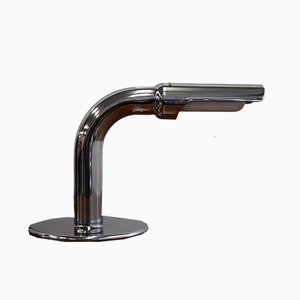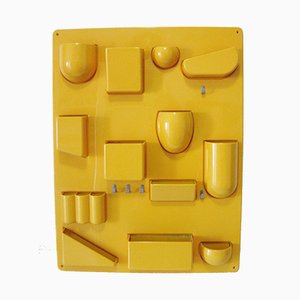Pioneering German lighting designer Ingo Maurer unveils new commission in Munich
Flights of Fancy
-
Designer Ingo Maurer at the opening reception for Pendulum
Photo © Stephan Görlich
-
Pendulum installed at the Pinakothek der Moderne, Munich
Photos © Patrizia Hamm
-
Ingo Maurer and his Team, YaYaHo, 1984
Photo © Ingo Maurer GmbH
-
Luccelino Table Lamp (1992) by Ingo Maurer
Photo © Ingo Maurer GmbH
-
Zettel’z 5 (1997) pendant lamp
Photo © Ingo Maurer GmbH
-
Blue Luzy (2018) pendant lamp, Ingo Maurer
Photo © Ingo Maurer GmbH
-
Lighting designer Ingo Maurer in 2007
Photo © Tom Vack
-
Bulb (1966), Ingo Maurer for Design M
Photo © Ingo Maurer GmbH
-
Ingo Maurer in 2015 with one of his desk lamps
Photo © Tom Vack
-
Blow Me Up (2017-18) lighting object, Theo Möller and Ingo Maurer
Photo © Ingo Maurer GmbH
-
My New Flame (2012) LED lamp by Moritz Waldemeyer and Ingo Maurer
Photo © Ingo Maurer GmbH
-
Flying Flames (2013) ceiling light by Moritz Waldemeyer and Ingo Maurer
Photo © Ingo Maurer GmbH
-
Flying Flames (2013) ceiling light by Moritz Waldemeyer and Ingo Maurer
Photo © Ingo Maurer GmbH
-
Ingo Maurer and his Team, Torre Velasca Blu, 2019
Photo © Tom Vack
-
The Pinakothek der Moderne museum in Munich
Photo © Die Neue Sammlung – The Design Museum (A. Laurenzo)
One of the most versatile lighting designers of the last generation, Ingo Maurer has been credited with many firsts. But the most recent has got to be one of his career highlights. Maurer was commissioned by the Neue Sammlung - The Design Museum to create the first site-specific work in a new series of ongoing commissions for the spectacular Rotunda in the Pinakothek der Moderne museum in Munich. The installation in the entrance hall of the building will be complemented by an exhibition of Maurer’s work in the Neue Sammlung galleries, scheduled to open in November.
Pendulum, Maurer’s simple yet monumental answer to the contemporary architectural grandeur of the space, is a highly-polished aluminium ellipsoid some three meters tall and 1.7 meters in diameter, hanging from the center of the towering glass-ceilinged rotunda. The mirror-like surface transforms the object, although it is not illuminated, into a subtle light source that reflects and amplifies the fluctuations in natural light throughout the day and over the course of the seasons. Pendulums have been a recurring theme in Maurer’s oeuvre, allowing the designer to mobilize light through simple means—and Pendulum in Munich is no different; the piece will periodically be set in motion and then be allowed to gradually swing back into place before the cycle is repeated, daily until the installation closes in February 2020.
Attending the press opening earlier this month, Maurer, now in his late 80s, looked gleeful perched atop his walking aid as he encouraged the white-gloved museum staff to push the giant pendulum harder and harder to make it swing in great arcs through the space. It was a telling moment in that it seemed to encapsulate the adventurous spirit that has characterized so much of Maurer’s career. While the impeccable finish and elegant simplicity of Pendulum speak to the designer’s maturity and professionalism, the slightly out-of-control feeling inherent in such a large object swinging in a public space highlights Maurer’s enduring enthusiasm for risk-taking—a quality that, no doubt, contributed to landmark designs like Bulb (1966); a table lamp in the shape of a glass light bulb, which became part of MoMA’s permanent collection in 1969.
In many ways Maurer was the natural choice for the first Pinakothek der Moderne Rotunda commission in Munich; a resident of the city for most his life, he built his internationally successful career from a base in the Bavarian capital. Born in 1932 in the Lake Constance region south of Munich, Maurer first trained as a typographer and graphic designer in Germany and Switzerland before moving to the US, where he worked as a freelance designer in New York and San Francisco. He returned to Europe in 1963 and three years later founded Design M in Munich—his design studio and the subsequent producer (with a name change to Ingo Maurer GmbH in the 80s) of almost all of his lighting pieces. Today, the company employees 60 people at the production hub in Munich and at the two permanent showrooms in Munich and New York, and works on a broad range of projects from commercial products to interior lighting design in public space, lighting installations, and exhibitions.
Perhaps the greatest evidence of Maurer’s mastery of his craft is how effortlessly he has moved with the times, creating designs that always seem fresh, forward-thinking, and of the now, both aesthetically and technologically. In 1984, the YaYaHo low-voltage lighting system became one of the first wire-hung systems for halogen lamps; in 2001 Maurer released EL.E.DEE, which is considered to be the first LED desk lamp; and in recent years, the octogenarian has kept up the pace, developing innovative luminaires like the Blow Me Up (2016) inflatable LED-lit light objects, or the tongue-in-cheek Flame Element (2013)—a collaboration with German artist-designer Moritz Waldemeyer, which uses LED pixels to mimic flickering candlelight.
Pieces like Blue Luzy (2018)—a pendant lamp consisting of a rubber glove reaching, like Adam’s finger in Michaelangelo’s Sistine Chapel, toward a naked bulb—clearly demonstrate that Maurer has certainly not lost his sense of humour. More than that, though, Blue Luzy is part of Maurer’s longer legacy of engaging with art history: Comic Explosion (2010) and Canned Light (2003) both refer to Pop Art, seeming to draw inspiration from Roy Lichtenstein and Andy Warhol, respectively; while the acclaimed Lucellino (1992) lamp is like something straight out of a surrealist painting. Its design is both accessible and full of in-jokes—a happy union of high and low brow.
Maurer has been highly decorated by the design community, receiving a Compasso d’Oro in 2011, the Design Award of the Federal Republic of Germany in 2010, and an Honorary Doctorate from the Royal College of Arts, London in 2006, just to name a few. His work is held in significant design collections around the world and has been the subject of exhibitions at leading institutions like the Vitra Design Museum and the Cartier Foundation for Contemporary Art. But what really seems to drive this designer’s fifty-plus-year career is curiosity, experimentation, and play—and that’s probably what makes his work so fun to look at and so exciting to live with.
Don’t miss Pendulum and the upcoming retrospective Ingo Maurer Intimate: Design or What? at Die Neue Sammlung - The Design Museum if you're passing through Munich this year.
More to Love
Brown Metal Table Lamp by Ingo Maurer for M Design

Bamboo Brass Floor Lamp by Ingo Maurer for Design M, 1960s

Scissor Lamp by Dorothee Becker & Ingo Maurer for Design M, 1968

Gulp Table Lamp by Ingo Maurer for Design M, 1970s

Vintage Yellow Uten-Silo by Ingo Maurer

Stainless Steel Spiral Table Lamp by Ingo Maurer, 1960s

ML1F Bamboo Floor Lamp by Ingo Maurer, 1968

Vintage Mahbruky Lamp by Ingo Maurer, 1990s

Large Table or Floor Lamp by Ingo Maurer for Design M, 1960s

Vintage Gulp Lamp by Ingo Maurer for Design M

MI 1F Bamboo Floor Lamp by Ingo Maurer, 1960s

German Bibibibi Metal and Porcelain Lamp by Ingo Maurer, 1982

Vintage Glass Lamps by Ingo Maurer for Design M, 1960s, Set of 3

Bamboo Floor Lamp by Ingo Maurer, 1968

Vintage Gulp Table Lamp by Ingo Maurer for Design M

Vintage Bamboo Table Lamp by Ingo Maurer for Design M

Mid-Century Pollux Wall Lamp by Ingo Maurer, 1973

















 Pendulum by Ingo Maurer installed in the Pinakothek der Moderne Rotunda, Munich
Photo © Stephan Görlich
Pendulum by Ingo Maurer installed in the Pinakothek der Moderne Rotunda, Munich
Photo © Stephan Görlich